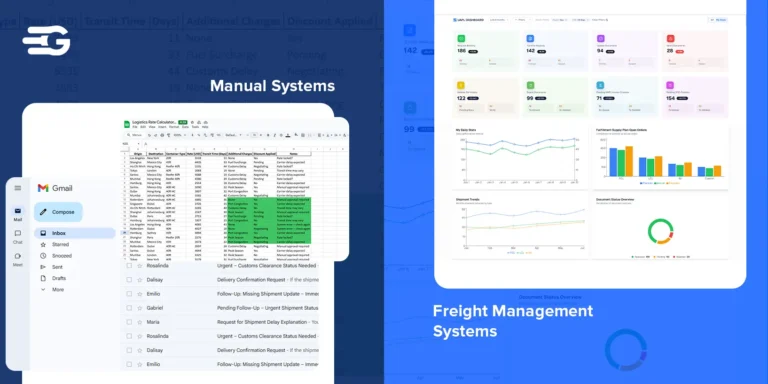Multi-Shipment Order Tracking: Can You Do It Without Spreadsheets
Many businesses still rely on spreadsheets to manage shipments. It’s a familiar setup and easy to start with. But as order volumes grow and shipment routes get more complex, the limitations of this approach become harder to ignore. Tracking updates across multiple tabs, chasing down the latest version, and managing manual entries quickly turns into a full-time task.
This is especially true for teams handling multi-shipment order tracking across regions or partners. Spreadsheets offer visibility, but not speed or accuracy at scale. We’ll dive into solutions in the following sections, but first, let’s understand the core limitations that slow teams down.
Limitations of Spreadsheets in Order Management
Spreadsheets have their place. They’re flexible, familiar, and frankly, they’ve helped keep operations afloat for years. However, when it comes to multi-shipment order tracking, that’s where things start to slip.
You’re not dealing with one shipment from Point A to Point B. You’re juggling orders moving across regions, time zones, and partners. And spreadsheets just aren’t built to keep up with that kind of complexity. Let’s break it down.
- Manual Data Entry Slows You Down
Every new entry. Every update. Every correction. It’s all on you or your team.
And when you’re managing multiple shipments, that’s a lot of copy-pasting, scrolling, and tab-jumping.
A global review found that nearly 9 out of 10 business spreadsheets have some kind of error. For high-volume order tracking, that kind of risk is impossible to justify.
One wrong ETA, and suddenly, the wrong product shows up at the wrong warehouse… and no one knows why.
What starts as a 10-minute update becomes a back-and-forth with vendors, carriers, and internal teams. All because a cell wasn’t updated.
- No Real-Time Visibility
Let’s say a shipment is delayed. Or stuck at customs. You won’t see it in the sheet unless someone manually updates it. That means your information is only as fresh as your last update, which could be hours old. Or worse, from last Friday.
In multi-shipment order tracking, you need visibility without chasing people for updates. But spreadsheets? They’re static. They don’t talk to your freight system, your warehouse tool, or your supplier network.
- Version Control Becomes a Nightmare
With multiple team members editing, reviewing, and uploading versions of the same file, it’s hard to know what’s current. One person makes changes. Another doesn’t see them. Mismatched numbers. Wrong SKUs. Conflicting ETAs.
Things break. Formulas get overwritten. Filters hide rows. As a result, you waste time fixing the sheet instead of fixing the actual shipment problem.
- Scalability Just Isn’t There
Tracking five shipments? Maybe manageable. Tracking fifty? The cracks start to show.
Spreadsheets don’t scale with your operations. They weren’t made for dynamic, fast-moving logistics with multiple partners involved. You end up building more sheets, adding more columns, creating workarounds (basically forcing a static tool to act dynamic). It’s like taping wheels on a filing cabinet and calling it a car.
- No Alerts. No Automation.
If something goes wrong in your spreadsheet… you won’t know. There are no automatic alerts. No triggers. No nudges that say “Hey, this order’s been pending too long” or “This shipment’s now overdue.”
In multi-shipment order tracking, waiting for someone to notice a problem is too late. The tool should flag it first. Spreadsheets don’t.
Embracing Automation in Order Management Workflows
You don’t wake up excited to update rows in a spreadsheet. Nobody does.
You want a system that just… works. That pulls data from your tools, updates in real-time, and tells you where every shipment stands without requiring you to chase anyone. That’s where automation can save the day.
Multi-shipment order tracking doesn’t have to feel like damage control. With automated workflows, it becomes a controlled, repeatable process, not a fire you put out every day.
With automation, you can enjoy a range of benefits:
- Live Data Syncing: You don’t need to refresh or wait for someone to upload the latest version. The system pulls updates directly from your ERP, TMS, and freight partners. Everything flows in real-time.
- Fewer Manual Errors: No more copy-paste mistakes or missed entries. Once the system is set up, it does the heavy lifting. That cuts down errors from human input and removes a ton of back-and-forth across teams.
- Scales Without Extra Headcount: Whether you’re tracking 10 shipments or 300, automated workflows don’t break under pressure. You don’t need more spreadsheets or more staff, but just better logic handling the flow.
- Built-In Accountability: Every order. Every update. Every exception. It’s all logged. You know exactly what happened, when it happened, and who touched it last. That audit trail? Gold during internal reviews or external audits.
- Better Team Collaboration: Everyone works off the same system. No version mismatches. No “Wait, which sheet are you using?” Just clarity.
At the end of the day, automation doesn’t just fix spreadsheet pain. It sets a foundation for smarter decisions and smoother coordination, especially in high-volume multi-shipment order tracking.
Kodak, for example, replaced manual tracking with GoComet’s automated visibility and now tracks over 2,500 shipments a year with reduced delays and fewer internal calls.
Now, let’s peel another layer. There’s a tool built exactly for this which gives you real-time control.
Why GoComet Is Built for Multi-Shipment Order Tracking
There are a hundred tools that promise visibility. A dozen more that say they “streamline operations.” But when you’re dealing with fragmented data, delayed updates, and multiple stakeholders across geographies… most of them fall short.
GoComet is different because it’s purpose-built for multi-shipment order tracking. It doesn’t just show you data. It connects systems, cleans up workflows, and brings actual control back into your hands.
Key Features
- Automated Data Integration
GoComet plugs into your existing tools (ERP, freight portals, warehouse systems) and automatically pulls order data from all of them. No manual sync. No CSV uploads. Just real-time flow from source to dashboard.
- Centralized, Easy-to-Read Dashboard
No more switching between tabs or chasing updates across folders. GoComet gives you one clean view where every order, every shipment, and every delay is visible. Not buried in a spreadsheet. Right where you can act on it.
- Seamless System Integration
Already using a TMS? No problem. Running orders through SAP, Oracle, or a custom tool? GoComet can still fit in. It’s built to integrate, not replace. That means smoother onboarding and zero workflow friction.
Real Results for Ops Teams
When everything is connected and automated, here’s what starts happening:
- Delays drop because you spot problems early
- Error rates go down since there’s no duplicate data entry
- Teams spend less time updating and more time solving
You don’t need to overhaul your operations to make this work. GoComet adds structure to what you already do. It simply makes multi-shipment order tracking faster, cleaner, and easier to scale.
Closing Thoughts
Managing multi-shipment orders through spreadsheets comes with too many moving parts. The gaps in updates, the risk of manual errors, the constant follow-ups. It all adds up. And as operations scale, these cracks turn into delays, miscommunication, and missed handoffs. Automation brings order to that chaos. It keeps things synced, visible, and easier to handle across teams.
If better control and fewer errors sound like the direction you want to move in, GoComet can help. You can book a quick demo and see how it simplifies multi-shipment order tracking, without overhauling your entire system.






